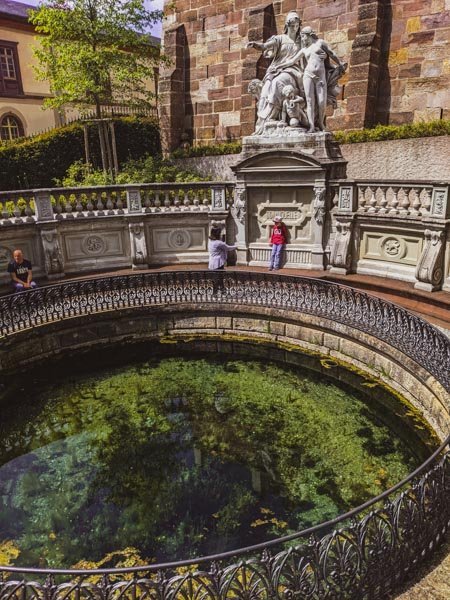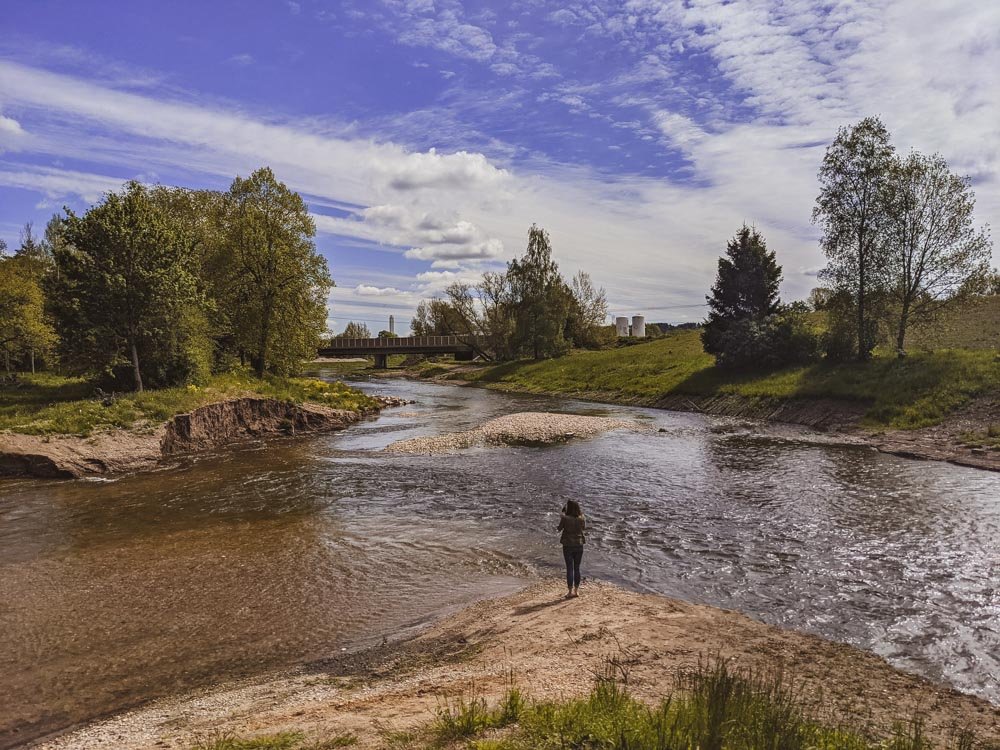Finding the True Source of the Danube in The Black Forest
The Danube (known as the Donau, in German) has long been a source of adventure for our family. Budapest, the second largest city on the river is one of our most favorite cities in Europe and we have fond memories of exploring other major sites along its banks like Vienna.
But despite the second largest river in Europe running through the geographies of so many historical sites and world events, there is something about the Danube that still feels wild and untamed.
So you can imagine our interest when we learned that the source of this mighty force has long been a point of contention and mystery. Sparking a bitter rivalry that resulted in the involvement of the state government, the story over the fight for the source of the Danube is a little-told tale in the history of the Black Forest.
Check out our post below for the history of the Danube, and the contentious and bitter feud for notoriety over its source.
Map of the Danube
History of the Danube
Although the Rhine often gets more international recognition, the Danube is the second-longest river in Europe (2,850 km or 1,770 mi), after the Volga River in Russia (3,530 km or 2,193 mi). From the Black Forest to the Black Sea, the Danube flows through much of Central and Southeastern Europe.
The Danube was once the long-standing frontier of the Holy Roman Empire. In fact, for more than 450 years, the Danube (called by the Romans, Danubius) formed the northern border of the Roman Empire and Roman port cities and castles lined its shores.
Today, visitors may recognize that the majority of the cities on the road of emperors and kings is of Roman origin: Regensburg (Castra Regina), Passau (Castra Batava), Linz (Lentia), Enns (Lauriacum) and Carnuntum (Petronell-Carnuntum about 40 km east from Vienna), Vienna (Vindobona) were ancient cities with temples, paved squares, theaters and arenas.
Fun Facts About the Danube
The Danube runs through or beside the largest number of countries in the world - 10 in total. (The Nile is second, with 9).
The Danube countries include: Germany, Austria, Slovakia, Hungary, Croatia, Serbia, Romania, Bulgaria, Moldova and Ukraine (from start to finish)
The Danube River flows through four national capital cities: Vienna, Austria; Bratislava, Slovakia; Budapest, Hungary; and Belgrade, Serbia.
In 1944, sensing defeat by the Allies was imminent, hundreds of German ships were scuttled in the Danube to avoid capture by the Soviet Union. Today, the shipwrecks can be seen from the banks of the Danube during summer, as the river’s water level falls.
Claims for the Source of the Danube
Despite the history and knowledge of this mighty river being so long standing, many may find it surprising to learn that the source of the Danube has been a point of contention.
But before we get there, it is important to define what the source and the start of the Danube mean. The start is simply the confluence of the two or more rivers, in this case the Breg and the Brigach. This is not up for debate. The source is the beginning of the largest river which feeds into the confluence. This is up for debate.
Read the sections below to learn more about those who claim to be the “true” source of the Danube.
Donaueschingen
For much of modern history, the Black Forest city of Donaueschingen has claimed to be the source of the Danube. The Donaubach (Donau Stream) rises on the castle grounds in a karst spring (a natural outflow of groundwater). The Donaubach enters into the Brigach River after flowing 90 meters below ground. The Brigach and the Breg rivers “officially” merge to become the start of the Danube after about 1.5 km. Resulting in the first two of many of the Danube’s tributaries.
Historically speaking, the Donaubach spring was long considered the source of the Danube. In the 15th century, Hartmann Schedel wrote about this location in his Weltchronik (World Chronicles) in 1493. However, historians have also suggested that its provenance has gone back much longer. Even in Roman Times, Pliny the Elder wrote about the region in Naturalis Historia.
Today, you can visit a beautiful round pool modeled after Adolf Weinbrenner’s 1875 design with the backdrop of the Donaueschingen Castle. The site is especially beautiful at night as it is illuminated from within.
You can also observe a group of statues created by the artist Adolf Heer in 1985. His design depicts ‘Mother Baar' pointing the way for her “daughter” the young Danube.
Although the presentation and fanfare over the source of the Danube in Donaueschingen is certainly the greatest - it is not without controversy. Other regional locales also claim to be the “true” source of the Danube.
Visit the Claimed Source of the Danube (Donauquelle)
While visiting Donaueschingen, we highly recommend to take the opportunity to visit the claimed source of the Danube, or the Donauquelle in German. The karst spring is encircled by a monument with the 'Mother Baar' statue we spoke of earlier.
Opening times for the Donaueschingen source of the Danube (Donauquelle) monument:
Donaquella in Donaueschingen.
April - October: 6AM-9PM
November - March: 7AM-6PM
Cost: Free
The Donauquelle monument is easily accessible with an elevator, good for those with strollers or disabilities.
Danube Start in Donaueschingen
Start of the Danube River (Zusammenfluss)
Visit the Start of the Danube (Zusammenfluss)
The start of the Danube can be found about 1.6km (~1 mile) outside of Donaueschingen. Although you can walk there, we would recommend taking a car if you have one as there is plenty of free parking.
We can't say we were terribly impressed at this attraction specifically, but it was still a unique experience for us to see the start of a river that flows through some of our favorite major cities.
At the time this article was written (June 2021), construction was underway to revitalize the area and put the start of such a significant river in a larger display.
We would definitely recommend visiting the start of the Danube if you happen to be near Donaueschingen.
Let’s further explore the source of the Danube.
Origin of the Breg River
As we mention above, the official start of the Danube occurs from the merger of the Brigach and the Breg rivers. So geographically and hydrologically speaking - the true “source” of the Danube would be the start of the greater of the two water flows: the Breg.
The spring of the river Breg is located just north of the town of Furtwangen im Schwarzwald next to the St. Martin’s Church.
As early as 1847, scholars identified the area then called “Martinskapelle” (Martin’s Chapel) in the Universallexikon des Großherzogtums Baden (Universal Lexicon of the Grand Duchy of Baden): “Danube, the biggest river of Germany, rises at the Martinskapelle in a wild and lonely area of the Black Forest, is called Breg river at its origin and forms the river Danube in Donaueschingen where it is unified with the Brigach river.
Danuvius Statue at Danube Source in Furtwangen
Visit the Scientific Source of the Danube (Donauquelle)
Take the opportunity to enjoy the beautiful drive to Furtwangen in the high Black Forest and visit the scientific source of the Danube. There is plenty of free parking with a free entrance to the monument.
It's a very short walk from the parking area and suitable for a stroller or someone with disabilities.
Bask in the beautiful surroundings of the high Black Forest and grab a drink or snack from the vending machine.
Entrance to the Donauquelle in Furtwangen
Battle for the Title: “Source of the Danube"
The hunt for the true “source of the Danube” has intrigued explorers and researchers for centuries. Famously, this exact mystery also interested the oceanographer Jacques Cousteau. In 1987, he filmed a documentary about the Danube around St. Martin's Church - giving further support to the origin of the Breg river as the source of the Danube.
However, for centuries the two cities Furtwangen and Donaueschingen competed for an official status which declares their own source as the official source of the Danube.
As we mention above, the city Furtwangen is located along the upper river Breg - the largest of the two water flows which feed the start of the Danube. However, the city Donaueschingen is located at the symbolic source of the Danube and the “official” start of the river by name.
Baden-Württemberg Steps In
Contentiously, the issue over the true “source of the Danube” even involved the state government of Baden-Württemberg. After the city council Donaueschingen intervened in 1981, for example, the Ministry of the Interior in Stuttgart announced that "the source of the Breg is not anymore displayed as the source of the Danube on ministerial maps. The land surveying office was instructed to act accordingly."
However, the former minister for agriculture and forestry confirmed in a document addressed to Prof. Öhrlein (the scholar who studied this topic fervorously) in 1982:
"Getting back to the issue regarding the source of the Danube, I can once again confirm that the so-called source of the Danube in Donaueschingen is certainly not the real source of the river Danube, if analysed with geographical and hydrological criteria. The river Breg can rightly be called the main stream of the Danube."
For the interested tourist, the city of Donaueschingen does seem to celebrate the “source of the Danube” the most, with more city monuments and local fan fare. However, you can find competing monuments at both locations still claiming to be the true “source”. For the time being, the debate seems to have quelled (pun intended).
Curiously, when visiting the websites for both Donaueschingen and Furtwangen im Schwarzwald, the cities use the tagline “am Ursprung” (at the origin) and “an der Quelle” (at the source), respectively. So perhaps, even if marginally, the feud lives on.
Other Contestants for the Source of the Danube
While the sources in Donaueschingen and Furtwangen are the two most well known claims for the source of the Danube - there are other less known, yet nonetheless contentious, claims to the fame.
Juniperusquelle
The source of the Juniperus (called “Juniperusquelle”), which is also located in the city of Donaueschingen has also been called the source of the danube as well.
Located in the city district o Allmendshofen, in the 18th century, it was not the Donaubach spring in front of Donaueschingen Castle, but the Juniperus spring that was given the questionable name of the Danube spring.
Source of the Brigach River
In 1719, Vikar Breuninger declared the source of the Brigach (the smaller of the two waterflows which merge into the Danube) as the source of the Danube. Located near the village of St. Georgen, the source is located at the Hirzbauernhof, a small farm.
Curiously, a sandstone relief, presumptively of Celtic origin circa 100 A.D. was found at the location. The relic features animals and heads, which have been interpreted as symbols for the Gods.
Today, a copy of it can be found at the source of the Danube and is often considered as a sainthood of the Source. However, other scholars believe that this stone was brought from the region of Western Baar to the "Hirzbauernhof (farm)" because of the way it is shaped (like a deer: in German Hirsch/Hirz).
Source of the Inn
Due to its height above sea level, the Swiss natural scientist Schleuchzer declared the source of the Inn river as the true source of the Danube.
From a hydrological aspect, the Inn in combination with the Flaz river can be indeed considered as part of the Danube main strand, although it might be due to the slightly higher average water flow.
Both of these rivers (Inn and Flaz) originate in southeastern Switzerland.






